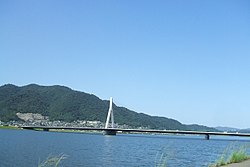| Ashida River | |
|---|---|
 | |
 | |
| Native name | 芦田川 (Japanese) |
| Location | |
| Country | Japan |
| Physical characteristics | |
| Source | |
| • location | Daiwa-chō, Mihara on the Sera Plateau in Hiroshima Prefecture |
| • elevation | 570 m (1,870 ft) |
| Mouth | |
| • location | Seto Inland Sea |
| • coordinates | 34°26′16″N 133°24′21″E / 34.4378°N 133.4058°E / 34.4378; 133.4058 |
| • elevation | 0 m (0 ft) |
| Length | 86 km (53 mi) |
| Basin size | 870 km (340 sq mi) |
The Ashida River (芦田川, Ashida-gawa) is a river that flows through the eastern part of Hiroshima Prefecture, Japan. The river provides the primary drainage for the Bingo region.
The source of the river is in the city of Mihara, Hiroshima and flows generally east toward Niimi, Okayama. After flowing through the Hattabara and Mikawa Dams in Fuchū, Hiroshima, the river passes through Fukuyama, Hiroshima, where it empties into the Seto Inland Sea.
Geography and development
The Ashida River originates in Daiwa-chō, Mihara on the Sera Plateau in Hiroshima Prefecture in Japan. It travels for 86 kilometres (53 mi) mostly eastward through eastern Hiroshima Prefecture, and has a drainage basin of 870 square kilometres (340 sq mi). This river is the primary drainage for the Bingo region.
Flood retaining walls were constructed along the banks of the Ashida River in 1928. It was designated as a Class A river in 1967.
In a report from 2015, the river was ranked the worst for water quality among the thirteen Class A rivers in the Chugoku region. Since 2012, the water quality in the Ashida River has improved significantly, with tributaries showing improvements between 17 and 43 percent.
Flora and fauna
In the 2020s, Okayama University conducted a study of the river to survey the population of Rhodeus suigensis in the river basin. The Japanese Ministry of the Environment had designated the species as extremely endangered. Environmental DNA analysis was utilized by the university to determine the concentration of the bitterling fish in various portions of the river.
References
- ^ Overview of the Ashida River basin and rivers, p.1.
- Overview of the Ashida River basin and rivers, p.20.
- Bill, Richard (15 September 1981). "Japanese Archaeologists Uncover Once Flourishing Medieval Port". Schenectady Gazette. p. 4. Retrieved 1 February 2024.
- Overview of the Ashida River basin and rivers, p.52.
- 芦田川水質4年連続ワースト [Ashida River water quality worst for four consecutive years] (in Japanese). Chugoku Shimbun. 20 July 2016. Retrieved 19 August 2016.
- "Current status of water quality of Class A rivers in the Chugoku region", p.6.
- Sexton, Chrissy (7 February 2023). "Environmental DNA can help track endangered species". Earth.com. Archived from the original on 9 February 2023. Retrieved 1 February 2024.
Works cited
- 芦田川水系流域及び河川の概要 [Overview of the Ashida River basin and rivers] (PDF) (in Japanese). Ministry of Land, Infrastructure, Transport and Tourism. Archived (PDF) from the original on 1 February 2024. Retrieved 1 February 2024.
- 中国地方一級河川の水質現況 [Current status of water quality of Class A rivers in the Chugoku region] (PDF) (in Japanese). Chugoku Regional Development Bureau / MLIT. 2022. Archived (PDF) from the original on 2 February 2024. Retrieved 2 February 2024.
| |||||||||||||||
| |||||||||||||||
| |||||||||||||||
| |||||||||||||||